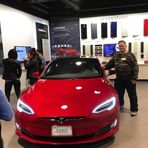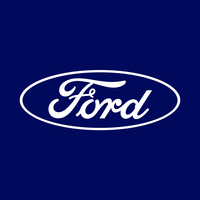Tesla's Robotaxi Rollout: A Leap into the Future or a Step into the Unknown?
June 24, 2025, 5:31 pm

Location: United States, Texas, Austin
Employees: 10001+
Founded date: 2003
Total raised: $3.86B

Location: United States, Michigan, Ypsilanti
Employees: 10001+
Founded date: 1896
Total raised: $40K
Tesla has taken a bold step into the future. The electric vehicle giant has launched its long-anticipated robotaxi service in Austin, Texas. This move sent Tesla shares soaring over 9% in a single day. The excitement is palpable. But is this leap into autonomous driving a calculated risk or a reckless gamble?
The robotaxi service began with a small fleet of self-driving cars. For a flat fare of $4.20, passengers can now experience rides without a human driver. This is a significant milestone for Tesla. It marks the first time the company has carried paying passengers in fully autonomous vehicles. The buzz around this launch is electric, but the road ahead is fraught with challenges.
Elon Musk has long touted robotaxis as a cornerstone of Tesla's future. He envisions a world where self-driving cars dominate the streets. This vision is not just about convenience; it’s about transforming transportation as we know it. However, the journey to widespread adoption is riddled with obstacles. Safety concerns loom large. Critics question the efficacy of Tesla's technology, which relies heavily on cameras and artificial intelligence. Unlike some competitors, Tesla does not use lidar or radar. This raises eyebrows, especially when considering adverse weather conditions. Fog, rain, and bright sunlight could pose significant risks.
The trial in Austin is tightly controlled. Only about ten vehicles are currently in operation, with front-seat riders acting as safety monitors. This cautious approach is necessary. The stakes are high. A single mishap could derail public trust in autonomous vehicles. Moreover, the National Highway Traffic Safety Administration (NHTSA) is scrutinizing Tesla's safety protocols. The company has labeled some of its safety data as confidential, which raises further questions about transparency.
The timing of this rollout is critical. Tesla's stock has faced headwinds this year, declining about 12%. Concerns about demand and Musk's controversial political stances have contributed to this dip. Investors are wary. Yet, if the robotaxi trial proves successful, it could add nearly $100 billion to Tesla's market value, which currently hovers around $1 trillion. The potential for growth is immense, but so are the risks.
Industry experts are divided. Some see this as a pivotal moment for Tesla, while others remain skeptical. The road to scaling up the robotaxi service could take years. Tesla must navigate regulatory hurdles, including a new Texas law requiring permits for self-driving vehicles. This law reflects a growing bipartisan call for caution in the rollout of autonomous technology.
The excitement surrounding the robotaxi service is palpable. Social media influencers have taken to platforms like X to share their experiences. Videos show the robotaxis navigating busy streets, deftly avoiding obstacles. The rides are described as comfortable and safe. Yet, these are just initial impressions. The true test will come as the service expands and faces real-world challenges.
Tesla's valuation is striking. The company trades at nearly 149 times forward earnings estimates. In comparison, Ford sits at 9.3, and tech giant Microsoft at 31.6. This disparity raises eyebrows. Is Tesla's valuation justified, or is it a bubble waiting to burst? Investors are betting on the future, but the future is uncertain.
Musk's vision for Tesla extends beyond robotaxis. He aims to revolutionize transportation and energy. However, the company must first prove that its technology is safe and reliable. The robotaxi trial is just the beginning. Success could pave the way for broader acceptance of autonomous vehicles. Failure could set the industry back years.
The implications of this trial extend beyond Tesla. If successful, it could reshape the automotive landscape. Other companies, like Waymo, are watching closely. They too are invested in the future of self-driving technology. The competition is fierce, and the stakes are high.
In conclusion, Tesla's robotaxi rollout is a bold move into uncharted territory. The excitement is infectious, but the challenges are daunting. Safety concerns, regulatory hurdles, and market skepticism loom large. As Tesla navigates this complex landscape, the world will be watching. Will this leap into the future pay off, or will it become a cautionary tale? Only time will tell. The road ahead is long, and the destination remains uncertain.
The robotaxi service began with a small fleet of self-driving cars. For a flat fare of $4.20, passengers can now experience rides without a human driver. This is a significant milestone for Tesla. It marks the first time the company has carried paying passengers in fully autonomous vehicles. The buzz around this launch is electric, but the road ahead is fraught with challenges.
Elon Musk has long touted robotaxis as a cornerstone of Tesla's future. He envisions a world where self-driving cars dominate the streets. This vision is not just about convenience; it’s about transforming transportation as we know it. However, the journey to widespread adoption is riddled with obstacles. Safety concerns loom large. Critics question the efficacy of Tesla's technology, which relies heavily on cameras and artificial intelligence. Unlike some competitors, Tesla does not use lidar or radar. This raises eyebrows, especially when considering adverse weather conditions. Fog, rain, and bright sunlight could pose significant risks.
The trial in Austin is tightly controlled. Only about ten vehicles are currently in operation, with front-seat riders acting as safety monitors. This cautious approach is necessary. The stakes are high. A single mishap could derail public trust in autonomous vehicles. Moreover, the National Highway Traffic Safety Administration (NHTSA) is scrutinizing Tesla's safety protocols. The company has labeled some of its safety data as confidential, which raises further questions about transparency.
The timing of this rollout is critical. Tesla's stock has faced headwinds this year, declining about 12%. Concerns about demand and Musk's controversial political stances have contributed to this dip. Investors are wary. Yet, if the robotaxi trial proves successful, it could add nearly $100 billion to Tesla's market value, which currently hovers around $1 trillion. The potential for growth is immense, but so are the risks.
Industry experts are divided. Some see this as a pivotal moment for Tesla, while others remain skeptical. The road to scaling up the robotaxi service could take years. Tesla must navigate regulatory hurdles, including a new Texas law requiring permits for self-driving vehicles. This law reflects a growing bipartisan call for caution in the rollout of autonomous technology.
The excitement surrounding the robotaxi service is palpable. Social media influencers have taken to platforms like X to share their experiences. Videos show the robotaxis navigating busy streets, deftly avoiding obstacles. The rides are described as comfortable and safe. Yet, these are just initial impressions. The true test will come as the service expands and faces real-world challenges.
Tesla's valuation is striking. The company trades at nearly 149 times forward earnings estimates. In comparison, Ford sits at 9.3, and tech giant Microsoft at 31.6. This disparity raises eyebrows. Is Tesla's valuation justified, or is it a bubble waiting to burst? Investors are betting on the future, but the future is uncertain.
Musk's vision for Tesla extends beyond robotaxis. He aims to revolutionize transportation and energy. However, the company must first prove that its technology is safe and reliable. The robotaxi trial is just the beginning. Success could pave the way for broader acceptance of autonomous vehicles. Failure could set the industry back years.
The implications of this trial extend beyond Tesla. If successful, it could reshape the automotive landscape. Other companies, like Waymo, are watching closely. They too are invested in the future of self-driving technology. The competition is fierce, and the stakes are high.
In conclusion, Tesla's robotaxi rollout is a bold move into uncharted territory. The excitement is infectious, but the challenges are daunting. Safety concerns, regulatory hurdles, and market skepticism loom large. As Tesla navigates this complex landscape, the world will be watching. Will this leap into the future pay off, or will it become a cautionary tale? Only time will tell. The road ahead is long, and the destination remains uncertain.
